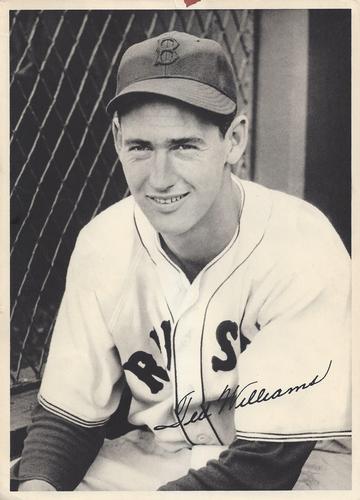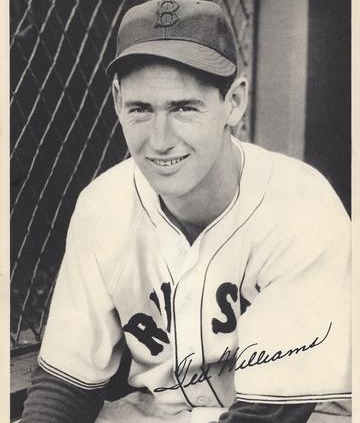June 12, 1941: Ted Williams’s two-run homer in third inning puts Red Sox ahead of Browns to stay
 The Boston Red Sox had won eight of their last nine games heading into the twin bill in St. Louis on June 12, 1941, but they hadn’t played for three days in a row, thanks to a scheduled offday and rainouts of their first two dates against the Browns.1
The Boston Red Sox had won eight of their last nine games heading into the twin bill in St. Louis on June 12, 1941, but they hadn’t played for three days in a row, thanks to a scheduled offday and rainouts of their first two dates against the Browns.1
They got off to a solid start in the doubleheader, scoring four runs in the top of the first inning of the opener. The advantage didn’t last; the Browns responded with five runs in the bottom of the first, and St. Louis’s Bob Muncrief took over from starter Bob Harris and threw 8 1/3 innings of scoreless relief. Boston starter Joe Dobson did not retire a single Browns batter. After Dobson faced six batters and saw them all reach base, Bill Fleming took over. He too worked in long relief – seven innings, allowing four runs. The Browns won the first game, 9-4.
The Thursday afternoon games were played before a small crowd, numbering 1,566. Luke Sewell had recently taken over the managerial reins of the Browns from Fred Haney. The Browns were in seventh place after spending most of May in the cellar. The Red Sox were in third place, five games behind first-place Cleveland.
Sewell’s starting pitcher for the second game was Johnny Niggeling, who was 0-3 to this point in 1941. Red Sox player-manager Joe Cronin started a left-hander, Earl Johnson.
All the scoring in the game took place in the first four innings.
The three Red Sox outfielders were at the top of the order. After center fielder Dom DiMaggio made an out, right fielder Lou Finney tripled, the ball going all the way to the fence in right-center field. Left fielder Ted Williams struck out. Cronin, playing shortstop, hit a single off the glove of St. Louis second baseman Don Heffner, and Finney scored. Though Jimmie Foxx walked and third baseman Jim Tabor reached on an error, the one run was the only one for the Red Sox thanks to Wally Judnich’s remarkable catch of Bobby Doerr’s line drive to right-center
Cronin committed a one-out error in the bottom of the first, and the Browns had a baserunner, but Judnich hit into a 4-6-3 double play to end the inning.
No one reached for the Red Sox in the second, but the Browns tied the score in the bottom of the inning, with a triple factoring into their scoring, too. Right fielder Chet Laabs hit a two-out double and shortstop Johnny Berardino followed with a triple to DiMaggio’s right in center field, tying the score.
Leading off the third inning, Finney singled. Wielding a new bat – he’d been angry at himself for striking out in the first inning and broke his bat on the plate – Ted Williams hit a two-run home run. As the Boston Herald reported, swinging at a 3-and-0 pitch, “Tall Ted teed off and belted the next pitch over the roof of the right-field pavilion and onto Grand Boulevard.”2 “The “winning wallop” went “a mile over the roof in right field” according to Hy Hurwitz of the Boston Globe.3 The Red Sox took a 3-1 lead. Once again, after scoring, the Red Sox put a couple of runners on base – Foxx walked and Tabor singled – but Bobby Doerr and catcher Johnny Peacock both made outs.
Johnson retired the Browns in order in their half of the third.
In turn, Niggeling retired the Red Sox in order in the top of the fourth. After the third inning. he allowed Boston batters only one hit the rest of the game.
The Browns knocked Johnson out of the game in the fourth. Judnich singled to center field. Left fielder Roy Cullenbine singled to left. And third baseman Harlond Clift singled to left field, too, driving in Judnich.
Joe Cronin had seen enough. He brought on Mike Ryba in relief, three days after Ryba’s 38th birthday. Laabs grounded into a 6-4-3 double play. Berardino also grounded to shortstop, Cronin throwing to Foxx at first base for the third out. The score stood Boston 3, St. Louis 2. The Boston Globe called Ryba “the dandy handy man.”4
The score never changed.
Niggeling walked Williams in the top of the fifth. Ryba walked Heffner in the bottom of the fifth.
Ryba reached on an error in the sixth. Cullenbine singled in the bottom of the sixth. Neither of them got as far as second base.
In the top of the seventh, Ted Williams drew a one-out walk. Joe Cronin struck out, and Williams was thrown out trying to steal second. Williams did steal two bases in 1941. His most productive years at stealing bases were 1940 and 1948, with four steals each year. Over the course of his career, Williams stole 24 bases and was caught 17 times. Remarkably, he stole at least one base in four different decades – two in 1939, 14 in the 1940s, seven in the 1950s, and one in 1960.
Ryba retired the Browns in order in the bottom of the seventh.
Foxx singled to lead off Boston’s eighth inning. With one out, first baseman George McQuinn doubled for St. Louis. With the score still 3-2, he represented the potential tying run, but did not score.
Neither Niggeling nor Ryba allowed a batter to reach base in the ninth.
Ryba earned the win, his record improving to 3-1. He finished the season 7-3. He had worked a full six innings in relief, allowing just two base hits and walking one. It was his sixth consecutive scoreless outing, the longest such streak of his career. Three days later, against the Chicago White Sox, he won another game, working 5 1/3 innings of relief while allowing just one unearned run.
Niggeling had dropped to 0-4. He finished the year 7-9, but in 1942 had one of his best seasons, going 15-11 with an ERA of 2.66.
The Red Sox finished the season in second place, but nowhere near the first-place New York Yankees; Boston finished 17 games behind with a record of 84-70. The Browns finished 70-84, tied for sixth place with the Washington Nationals.
The Williams home run in the third inning was the winning hit. It was his fourth game-winning home run in a 17-day stretch.5 The others had been on May 27 and 29 against the Philadelphia Athletics, and June 6 against the White Sox.
Williams was 2-for-7 in the doubleheader and saw his batting average drop from .416 to .410. His next three games were all multihit games and he boosted his average to .425 through June 15.
By the end of the 1941 season, Williams had 37 home runs, leading both the American and National Leagues. He drove in 120 runs. Most notably, he had a .406 batting average, the last time any player from either of the leagues surpassed the .400 mark. He often reached base in other ways, too. His 147 bases on balls led both leagues. He drew 25 intentional walks. Williams had a .553 on-base percentage for the season.
Acknowledgments
This article was fact-checked by Andrew Harner and copy-edited by Len Levin.
Sources
In addition to the sources cited in the Notes, the author consulted Baseball-Reference.com and Retrosheet.org.
https://www.baseball-reference.com/boxes/SLA/SLA194106122.shtml
https://www.retrosheet.org/boxesetc/1941/B06122SLA1941.htm
Notes
1 Those games were made up in August; the June 12 doubleheader included a makeup of a game postponed from Boston’s visit in May.
2 John Drohan, “Ryba, Williams Give Sox 3-2 Nightcap Win,” Boston Herald, June 13, 1941: 33. The St. Louis Globe-Democrat agreed that the ball had left the park and gone to Grand. See Glen L. Wallar, “Relief Hurlers Shine as Browns Split Bill,” St. Louis Globe-Democrat, June 13, 1941: 3B.
3 Hy Hurwitz, “Ryba’s Relief Work Saves Sox,” Boston Globe, June 13, 1941: 28.
4 Hurwitz.
5 A “game-winning home run” is defined here as a home run that provides a game’s final margin of victory, giving the winning team at least one more run than the opposing team scored. For example, if a two-run homer increased a team’s lead from 2-1 to 4-1, and it went on to win 4-3, it qualifies as a game-winning home run. (This is different from the definition of “game-winning RBI” in baseball’s official statistics from 1980 through 1988, which counted as “game-winning” the RBI that provided a winning team the lead that it never relinquished.)
Additional Stats
Boston Red Sox 3
St. Louis Browns 2
Game 2, DH
Sportsman’s Park
St. Louis, MO
Box Score + PBP:
Corrections? Additions?
If you can help us improve this game story, contact us.


